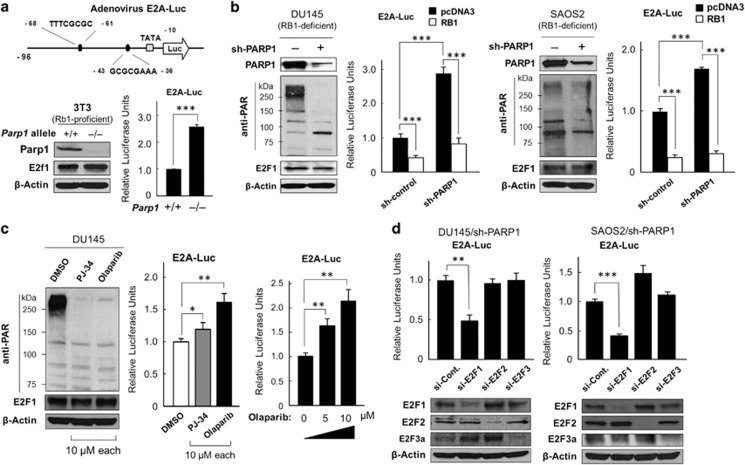Figure 1.
PARP1 is essential for repressing E2F1-induced transcription, regardless of RB1. (a) Endogenous E2F activity was monitored by the transfection of mouse 3T3 Parp1+/+ and Parp1–/– fibroblasts with E2A–Luc, an adenoviral E2A-promoter-driven luciferase reporter vector.14,15 The E2A gene promoter contains a TATA box, followed by two canonical E2F-consensus sequences: 5′-GCGCGAAA-3′ and 5′-TTTCGCGC-3′.26 Parp1 and E2f1 levels were determined with western blotting. β-Actin was used as the internal loading control. ***P<0.0005. (b) Two RB1-defective human cancer cell lines, DU145 and SAOS2, were stably infected with a short hairpin (sh)-PARP1 recombinant lentivirus and subjected to western analysis, with an anti-poly(ADP-ribose) polymer chain antibody (anti-PAR). The effects of sh-PARP1 and RB1 transfection on endogenous E2F activity were monitored with E2A–Luc assays. ***P<0.0005. (c) DU145 cells were treated with PJ-34 or olaparib for 72 h and subjected to western analysis with an anti-PAR antibody or E2A–Luc assay. *P<0.05, **P<0.005. (d) DU145/sh-PARP1 and SAOS2/sh-PARP1 cell lines were cotransfected with siRNA directed against E2F1, E2F2, or E2F3a and E2A–Luc. The depletion of each E2F protein was checked with a western analysis. si-Control RNA (si-Cont.) was used as the negative control. **P<0.005

